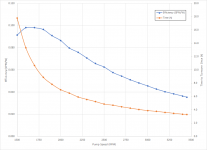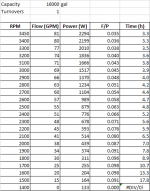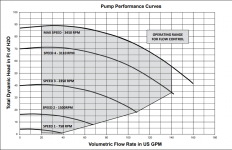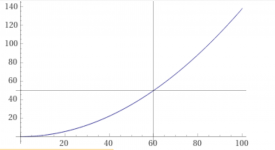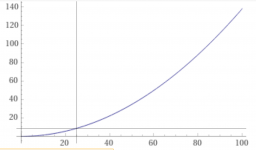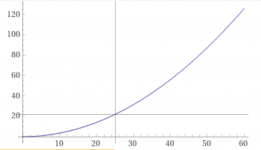- Oct 3, 2020
- 10
- Pool Size
- 16000
- Surface
- Plaster
- Chlorine
- Salt Water Generator
- SWG Type
- Pentair Intellichlor IC-40
Finished putting our pool in last month, being an engineer I like the data available from the VSF. Wondered what the most efficient setup was for the pool, so using the speed, flow, and power readings from the ScreenLogic app on the PC, I made a psedu-efficiency curve. Note that this only applies to my pool, the head loss on another pool will be different. I simply took the flow rate and divided it by power draw to determine the efficiency curve.
The flow rate went to zero at 1400 rpm, so that's the minimum in the experiment. Not that it matters, at 1700 rpm the flow is 25 GPM, which is the minimum flow rate for the IC40 chlorinator. Actually, the IC40 spec says 25±5 gpm, so to be on the safe side I consider 30gpm to be the minimum, which correlates to 1800 rpm and 311W. For my pool this correlates to a 9 hour turnover, but I'm running it 11 hours a day, as my home solar covers it. During the winter, I'll drop that down to 9 hours.
Just thought I'd share, if you have a VSF it's an easy way to determine your most effective/efficient speed. Only takes 15 minutes or so to do.
The flow rate went to zero at 1400 rpm, so that's the minimum in the experiment. Not that it matters, at 1700 rpm the flow is 25 GPM, which is the minimum flow rate for the IC40 chlorinator. Actually, the IC40 spec says 25±5 gpm, so to be on the safe side I consider 30gpm to be the minimum, which correlates to 1800 rpm and 311W. For my pool this correlates to a 9 hour turnover, but I'm running it 11 hours a day, as my home solar covers it. During the winter, I'll drop that down to 9 hours.
Just thought I'd share, if you have a VSF it's an easy way to determine your most effective/efficient speed. Only takes 15 minutes or so to do.


